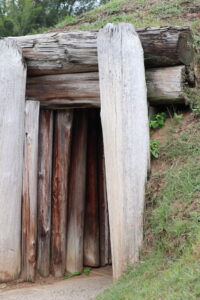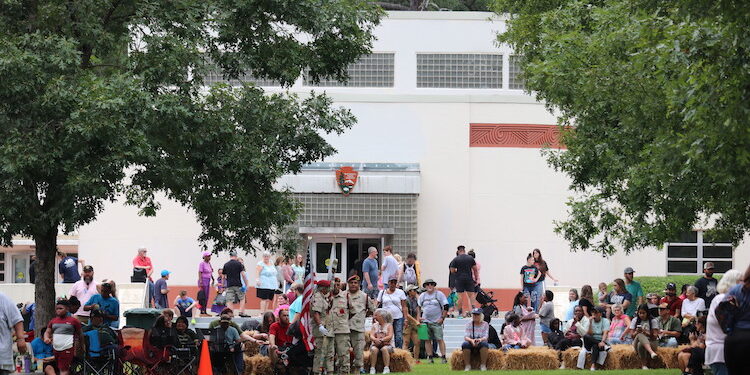MACON, Georgia – Departments from the Muscogee (Creek) Nation and members of local Creek community centers traveled from the current home of the Muscogee people, to the ancestral lands for the Ocmulgee Indigenous Celebration held on Sept. 16-17 in Macon, GA.
The two-day festival started each morning with the Mvskoke Honor Guard posting the colors. It featured storytelling from various tribal members, traditional cultural crafts, traditional ceremony demonstrations, cultural instrument playing, and other music and dances related to the Mississippian tribes.
Vendors selling handmade Native American arts and crafts lined the parking lot and grassy areas of the park, along with various MCN Department booths.
Community members traveled to the homelands after months of fundraising to sing traditional Mvskoke Hymns. For some members, it was not their first time attending the celebration.
Miss Muscogee Nation Chenoa Barnett took the stage to introduce herself to attendees in the Mvskoke language. She invited attendees to visit the Mvskoke Royalty Department booth, which handed out promotional items that included a bag, a water bottle, or a notebook.
A stomp dance demonstration from various members of a ceremonial ground was performed, Ty Hicks led the group and spoke to festival participants about the significance of the dance.
Hicks had his young daughter with him, and led as she shook cans behind him.
“Time only moves in one direction,” Hicks said. “My father was Red Hicks, he used to drive the bus on this trip and led the dance for all you to see.”
Although the dancing group was small, Hicks mentioned to the audience that the demonstration was merely a portion of what actually takes place during the ceremony.
“Do consider yourself lucky to see what’s going on here today,” Hicks said. “Our ceremonies we carried with us from here to where are now are not to be seen, we keep them sacred to us.”
Passing along Tradition
Jarrett Wildcatt (Eastern Band of Cherokee Indians) played a traditional flute and told the creation stories of the Mississippian tribes.
He told stories of the animals and how they came to be, the stories before land when the earth was only water.
William Harjo (Mvskoke) played music and told stories passed down from his ancestors as well.
Raised in Texas, Harjo is full blood Mvskoke, and has kept his traditions alive.
After the storytellers finished telling their stories, the Eastern Band of Cherokee Indians demonstrated a NVNVHI Warrior’s dance that each warrior danced in times of war.
Out of the group of five, one was an elder. As one of the young men started a loud yell, the other repeated his cry.
The elder Cherokee man said, “We have danced this dance for many, many years. It is dedicated to all warriors and even honors Veterans like those here today. Just like we fought for our people and land, you fight to defend your country.”
Mystic Wind Choctaw social dancers held a demonstration, and gathered all willing attendees involved. The Choctaw Youth played stickball to give another ceremonial demonstration.
Pedro Zepeda (Seminole) told stories of the Florida Seminole tribe, whose ancestors also dwelled in the Macon area.
The program held an afternoon portion that repeated the list of the events each day.
The second day, Wotko Long (Mvskoke) played his flute and shared more stories passed down to him.
Despite a little rain on Sunday, that did not deter the festival from proceeding with the same agenda.
According to the park rangers at the information booth, the first day alone attracted over 4,000 attendees. They claimed the second day of the event is not typically as busy as the first.
Many of the attendees were non-Natives seeking a learning experience and a fun outing for the family. Others came with long-lost Native ties from those who stayed in the area, with no Dawes Rolls to trace their lineage back to.
Those inquiring about the Native people of the land were enriched in the culture for the day.
According to Visit Macon President and CEO Gary Wheat, the Mvskoke population only reaches about 411 individuals in the area, but the culture of the Mvskoke people is rich.
From the Ocmulgee River flowing through the city, to the Great Temple Mound view of Macon, the presence of the Indigenous people is felt.
Ocmulgee Mounds National Park Public Information Officer Carla Beasley said that out of her staff of 12, none have tribal affiliation.
The festival is one of the only times during operation that the park has Native American people on site.
“We work really closely with the Muscogee Nation to provide accurate information to daily visitors,” Beasely said.
The festival is one way the staff can also learn by asking questions to tribal members. Staff members often gather questions throughout the year from park attendees.
On a really busy day, the park may see close to 300 people.
What can attendees see while visiting?
The site houses a museum that is filled with artifacts and information covering the Indigenous inhabitants that were found during an archaeological dig in the 1840s.
During the century-old excavation, an underground room was discovered along with over 17,000 cultural, traditional, and ceremonial pieces.
This room would be preserved and later reconstructed to what is called the Earth Mound. This mound can be entered, visitors can see where many possible ceremonies, discussions, and community meetings were once held.

Taking a short walk, the Great Temple Mound can be seen. Walking further, visitors can walk on to the top of the mound and see for miles. The town of Macon can be viewed at its 55 feet height from the ground along with the Ocmulgee River.
A theater located in the museum showcases a film that describes the life that once lived there.
Exhibitions of stickball, fishing, hunting, government operations, and basic living can be found in the museum.
With what can be viewed in the museum, and seen throughout the park, the Mvskoke culture can be felt, especially as one walks the trails to see where the Native Americans of the area once lived.
The park normally operates each day of the year, excluding major holidays, from 9 a.m. – 5 p.m.
For more information about the Ocmulgee National Park, visit: https://www.nps.gov/ocmu/index.html.





